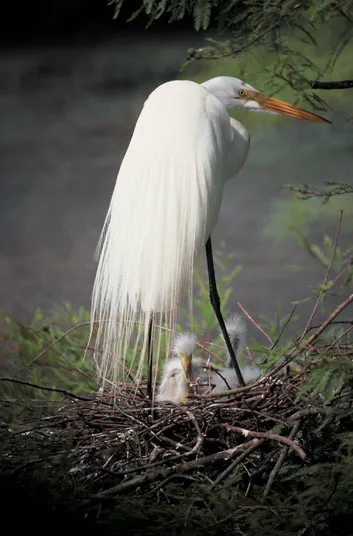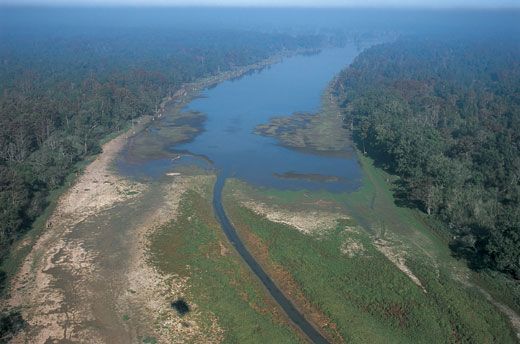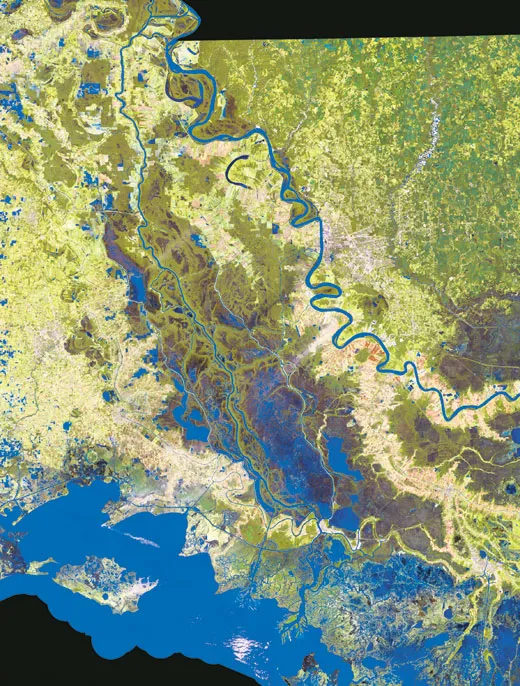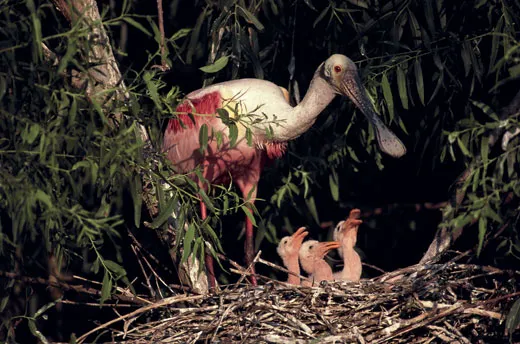Saving Atchafalaya
A more than 70-year effort to “control” America’s largest river basin swamp is threatening the Cajun culture that thrives on it
“You got him, Alice?” It’s a little after midnight deep in the heart of Louisiana’s fabled AtchafalayaBasin. Mike Bienvenu is yelling good-naturedly from the back of his 18-foot aluminum skiff. “You missed that last one, so if you want frog, you better have him good!” Dressed in camouflage, Mike’s blonde, ponytailed wife hangs over the bow, arms buried in goo. For the past two hours, the Bienvenus have been on the lookout for supper, their powerful headlamps illuminating herons, white-tailed deer and the orange-red eyes of alligators. Now Alice grunts and rears back, gripping a foot-long bullfrog in her muddy fists. “I’ve been froggin’ since I was 5 years old,” she says defiantly. “I knew I had him.”
The Basin, as locals refer to America’s largest river swamp, is a near million-acre maze of picturesque meanders and quiet bayous in south-central Louisiana, just west of Baton Rouge. It’s a fascinating, spooky, dangerous place, especially for those who don’t know it. Fishermen drown, hunters get lost, trappers suffer violent mishaps. “Accidents happen here all the time,” Alice Bienvenu says. “The sport fishermen are always in a hurry to catch a fish. They hit a log or something and fly out of their boat.”
The Bienvenus, like most of their neighbors, are Cajuns, descendants of the French-speaking Acadians who were expelled from eastern Canada by the British in 1755 and subsequently settled here. Many depend on the swamp year-round for hunting and fishing, but they fear it all may soon come to an end. Silt is filling in the swamp, and private landowners are cutting off access to traditional fishing holes. Basin fisherman Roy Blanchard, 63, says, “It’s a way of life that is now dying.”
Not that the Atchafalaya isn’t still swarming with critters. Gators 12 feet long share its murky depths with 80- pound catfish, venomous water moccasins and gaspergou, silver fish that make a loud “croak.” Roseate spoonbills soar above woods filled with more than 250 other species of birds. There are crawfish by the millions, a handful of Louisiana black bears (a threatened subspecies) and ducks beyond counting.
Yet the Basin today is a mere shadow of what it once was. During the past several decades, it has been engineered into an artificial flood-control structure—a 125-mile-long chute, 15 miles wide, surrounded by 25-foot-tall levees. Its waters have been dredged and straightened. Much of what’s left is choking in silt and blotched with stagnant ponds. “The Atchafalaya has suffered wave upon wave of degradation,” says Oliver Houck, director of the environmental law program at TulaneUniversity in New Orleans. Charles Fryling Jr., a professor of landscape architecture at LouisianaStateUniversity in Baton Rouge, agrees. “It’s so big, it’s easy to think there’s nothing people can do to harm it,” he says. “But we’ve cut down the trees, we’re suffocating the crawfish and we’ve replumbed the natural flow so it practically works backwards.”
The good news is, help is on the way. State and federal agencies have launched a $250 million project to restore the Atchafalaya to its former glory. One aim is to make it a magnet for tourism. Along Interstate 10 between Baton Rouge and Lafayette, a $5 million welcome and environmental-education center is slated to open early next year. Crews are repaving miles of rutted levee roads and clearing new canoe, bird-watching and biking trails. Sandra Thompson, who heads up the state’s Atchafalaya Basin Program, says the swamp would be lost otherwise. “If we don’t move the sediment out,” she says, “it will eventually fill the Basin in.”
The idea is to make the swamp work the way it used to— like a colossal sponge. For untold centuries, the Basin soaked up the Mississippi River’s annual floodwaters and distributed them throughout its river, bayous, lakes and marshlands. That brought much-needed nutrients to fish and wildlife and laid down rich natural levees of soil where oak trees can grow. “It was a beautifully balanced system,” says Greg Guirard, a crawfisherman, writer and photographer who lives near St. Martinville. “Water flowed in and spread all around. There was nothing to hold it back or hem it in.”
By the time the Acadians arrived in the 1760s, France had ceded Louisiana west of the Mississippi to Spain; Britain controlled the lands east of the river. Although Spanish officials were only too happy to welcome Catholic settlers with a grudge against the British, the Spaniards could not afford to be generous. “Each family received one land-clearing implement— a saw, ax or hatchet—one rooster, six hens, a gun and ammunition, and enough corn to last for approximately three months,” says Carl Brasseaux, a historian at the University of Louisiana. “Then they were turned out into an alien land.” The first groups settled along the Mississippi River and in the present-day St. Martinville area, while later arrivals mostly scattered into the prairies west of Lafayette or on the high grounds near Bayou Lafourche, which formed the Basin’s west and southeast boundaries. The prairie Acadians raised cattle. The so-called bayou Cajuns grew cotton and sugar cane.
For decades, the Atchafalaya’s mysterious interior repulsed all but the most intrepid hunters and trappers. By the 1840s, a few small communities of Acadians, free blacks and others had cropped up on ribbons of high ground, and steamboats plied regular seasonal routes. But the main body of the Atchafalaya remained impenetrable—a “weird and funereal” place, in the words of one visitor.
Mishaps were common, and medical attention was hard to come by. Fishermen injured by sharp fish spines often got blood poisoning. Says Jim Delahoussaye, a 65-year-old biologist who lives in the middle of the Basin and fished it commercially for years: “When they saw that red line crawling up their arm or legs, they took ‘whisky roaches,’ which was the cheapest whisky you could find with drowned black roaches in it. They would take that liquor by the teaspoonful and they would be cured.”
In the chaotic aftermath of the Civil War, thousands of dispossessed people turned to the swamp for survival, at last penetrating its deepest recesses. The “swampers” killed, cut and collected anything that could be sold. Hordes of pickers pulled mats of Spanish moss from trees with hooked wooden poles. After curing outside in huge heaps, the moss was baled, ginned and peddled for as little as a penny a pound as mattress and upholstery stuffing. Muskrats and gators were trapped and shot for their hides. Fishing became a big business, and hunters shipped a quarter-million ducks to New Orleans some years.
Little by little, local settlements grew. By the mid-1870s, one of the largest towns, Bayou Chene, boasted a population of 450 and several saloons. In the early 1900s, houseboats and motors increased the swampers’ range, and by the early 1930s, nearly 1,000 full-time fishermen were dropping their lines and nets in the Atchafalaya. Perhaps twice as many parttimers headed for the bayous after toiling all day in sugar cane fields or on cattle ranches.
There was almost no limit, it seemed, to the ways a resourceful person might survive. In summer, for example, many a swamper collected snapping-turtle eggs from bayou banks where turtles nested, frequently in the company of gators. “First you had to slide them gators out,” recalls Raymond Sedotal, a 79-year-old Cajun from Pierre Part. “Most of the time they’d sleep, but if they woke up, then, boy you had somethin’.”
Water, the lifeblood of the swamp, proved its undoing. In 1927, a historic flood poured through the lower Mississippi River valley, inundating 16 million acres in Kentucky, Tennessee, Arkansas, Mississippi and Louisiana, destroying 41,000 buildings and killing hundreds. In the Basin’s main river, also called the Atchafalaya, floodwaters rose seven feet above its natural levees. Swamp residents threw together log rafts for their livestock, then fled. According to local legend, a goat left stranded in the Methodist church at Bayou Chene survived for weeks on hymnals and wallpaper.
Under intense political pressure to prevent a repeat of that catastrophe, the U.S. Army Corps of Engineers—which by law is charged with dredging harbors, managing dams and keeping the nation’s rivers under control—came up with a mind-boggling scheme: to transform the entire Atchafalaya Basin from a sponge that absorbed floodwaters into an emergency valve that flushed them out. Whenever Old Man River went on the rampage, the reconstituted swamp would move water downstream quickly.
Since 1928, the Corps has spent almost $2 billion on flood control in the Basin, including enclosing more than a halfmillion acres of swamp with 450 miles of levees. Dozens of natural bayous have also been sealed off, and more than 100 million cubic yards of earth have been dredged. Ahuge concrete structure built at the junction of the Mississippi and Atchafalaya rivers enables the Corps to divert some of the Mississippi into the Basin. That’s good for Baton Rouge, New Orleans and the dozens of chemical plants crowding the Mississippi’s lower banks because it means less flooding during times of high water. But the reengineered Basin no longer retains the water it needs to survive; instead it is flushed into the Gulf of Mexico.
Oil and gas development have only made matters worse. Beginning in the 1940s, hundreds of miles of pipelines and navigation canals were punched through the Basin’s woods and across its swamplands, interfering with natural water flow and trapping huge piles of sediment. Lakes shriveled, wetlands began drying up and, in many areas of the Basin, crawfish harvests declined.
What corn is to Iowa and the lobster to Maine, the crawfish has become to Louisiana—not just a lucrative cash crop but a state symbol as well. The lowly crustacean’s improbable rise to culinary stardom is of relatively recent vintage. In the 1940s, Cajun restaurateurs began experimenting with tasty dishes featuring boiled crawfish, and in no time at all crawfish became wildly popular with natives and visitors alike. Soon every boat in the Basin big enough to hold a four-foot wire crawfish trap was being pressed into service.
After crawfish farming in man-made ponds started up in the 1960s, Louisiana’s overall annual harvest typically rose to about 80 million pounds. In just two years of harvesting wild crawfish during the 1970s, swamper Roy Blanchard made enough money to build a house and pay cash for a new truck.
Mike Bienvenu started crawfishing commercially in the swamp right after he graduated from high school in St. Martinville in 1973. At that time and throughout the ’80s and early ’90s, he recalls, “It was nothing to catch 2,000 pounds of crawfish in a day.” But before long the combined effect of all the levee building and canal digging began to take its toll. Last year the wild crawfish harvest was down to about 14 million pounds, half the average annual catch. Although Mike and Alice continue to set out more than 1,000 traps at a time, their daily catch has dwindled to less than 600 pounds. “The natural crawfish habitat is ever-shrinking,” says Tulane’s Oliver Houck. “It’s impounded, it’s silting up.”
Bringing back the crawfish means bringing back the freeflowing water. In 1986, after years of legal and political wrangling, Congress gave the agency that had done so much to damage the Atchafalaya a bold new assignment: fix it. And now after much planning, the Corps, working with state and federal agencies, is ready to restore the natural water flow by unplugging bayous and eliminating sediment by cutting gaps into high banks along pipelines and canals. The agency is also trying to preserve more than 337,000 acres of wooded swamp land by buying up environmental easements to control development.
There’s more at stake than crawfish. Louisiana is betting that tourism will be the swamp’s next big boom. Not only is the state spending $85 million on boat ramps, recreationalvehicle facilities and hundreds of miles of trails; a regional group is promoting travel in the so-called Atchafalaya Trace Heritage Area, hoping to coax visitors into Cajun dance halls, restaurants and historic sites. Some officials believe visitation could double in the next 15 years.
But if it’s easier for tourists to get into the Atchafalaya these days, it’s harder for locals who’ve been using the place for generations. That’s because large private and corporate landowners are selling exclusive leases to hunting clubs and individuals and keeping just about everybody else out. Rudy Sparks is a vice president of Williams Inc., a lumber company that manages oil and gas leases on some 35,000 acres of Basin lands. “We’ve had to do this to manage the lands in a sustainable way,” he says.
“But access to the Basin is one of the Cajuns’ last links to our heritage,” says Patrick Deshotels, a curly-haired biologist with the state Department of Wildlife and Fisheries. “So much of the bayou culture revolves around this ecosystem— squirrel hunting, crawfishing, going to houseboats with your kids. If we can’t even get in there anymore, then that part of our culture is lost.”
As the head of a local crawfishermen’s group, Bienvenu often attends meetings like the one held on a warm night not long ago in Catahoula, by the Basin’s west levee. In a fishing camp, 15 crawfishermen sat, arms crossed and caps pulled low over their brows, telling of padlocked iron gates across bayous they’ve fished for years and of hand-lettered signs warning, “Keep Your Ass Out.” There were stories of harassment. “They threatened to throw us in jail until we filed a lawsuit,” Bienvenu says. All he and his fellow fishermen want, he insists, is to do “what we’ve always done.”
Most Cajuns hope that restoration of the Atchafalaya will grant crawfishermen that fond wish—to continue fishing the swamp as their ancestors did—but many, like Roy Blanchard, worry that it may be too late. Early on a cool, quiet morning, he slips his skiff into Lake Fausse Pointe, a 6,000-acre swath of water and swamp woods adjacent to the Basin. He steers through serpentine channels into open water, where rafts of white pelicans take to the air. “Oh, yes, boy,” he tells his companions. “This is the place to see what the Basin used to be.”
For nearly four decades, Blanchard worked with his wife, Annie, setting gill nets, catfish lines and crawfish traps. A few years ago, he gave it up and took a job at a motel. Now he returns to the swamp to hunt, and uses his boat, modified with extra seats, for tourist trips. “As for making a good living out here in the Basin,” he says, cutting the motor in a grove of soaring cypress trees, “it’s almost gone.”



